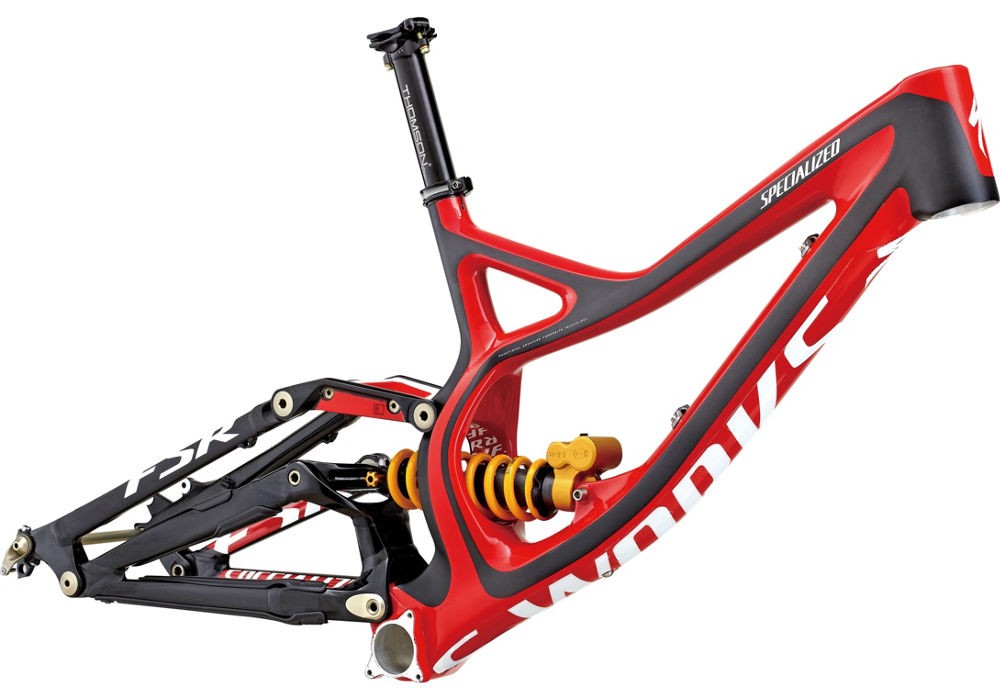Bike: 2014 Specialized S-Works Demo 8

Size Tested: Medium
Geometry: (check it out here)
MSRP: $8,500
Weight (w/ 530g Time Z pedals): 38 lbs / 17.24 kg
Build Overview:
- Drivetrain: SRAM XO
- Brakes: Avid Code XO World Cup
- Fork: RockShox Boxxer World Cup
- Shock: Õhlins TTX22M
Days Tested: 7
Location Tested: Whistler, BC
The Specialized Demo has been around for quite a while now, and each year Specialized has made small tweaks and adjustments to the design, with the S-Works model Demo always sitting at the top of the heap. As I write this, details are starting to emerge about the 2015 S-Works Demo, which sees some significant changes over the 2014 model reviewed here: a single-sided seat tube, a different rear end, longer, slacker geometry numbers, and 27.5” wheels.
But while the top-end S-Works Demo is undergoing somechanges for 2015, the “regular” 2015 Demo models below it will still share the same frame design as this 2014 S-Works Demo 8 I rode over a week at Whistler. (I’ve also spent the last two seasons on a Demo 8 I.)
You’re likely to see some bigger wheels on many of the 2015 Demos, but the basic characteristics of their frames will likely be very similar to the 2014 S-Works Demo. So even if you are planning on buying a brand new bike from the Demo line in 2015, unless you’re shelling out for the new S-Works, my findings here still ought to come in handy.
Construction
The S-Works has a few notable features that aren’t found on any of the other Demos. Specifically, the frame’s front triangle is made out of FACT 11mm carbon, which is the highest grade carbon used by Specialized. (In case you’re wondering, Fact stands for “Functional Advanced Composite Technology.”)
The FACT 11mm carbon on the S-Works frame is one step up from the FACT 10mm carbon used on the Demo 8 I Carbon, the model just below it in the Demo line. The FACT 11mm carbon is a higher modulus carbon than the FACT 10m and the other, lower modulus carbons used on other frames. Essentially a higher modulus just means that it’s stiffer, which in turn means that Specialized can use less material to achieve a stiff frame, saving weight.
The S-Works Demo also has a magnesium swing link as opposed to the aluminum link found on the lower-end models. Having played with various magnesium and aluminum links in the past, I can say that the magnesium links are quite a bit lighter and stiffer.

Between its FACT 11mm frame and magnesium swing link, Specialized claims that the S-Works Demo frame is around 530 grams (1.17 lbs) lighter than the aluminum version. That’s a pretty significant weight reduction considering how similar the S-Works frame is otherwise, and I think we can safely assume that the 2015 S-Works will be even lighter still.
With the exception of the swing link, the rear end of the 2014 S-Works Demo is made out of aluminum (the new 2015 version has a carbon rear end). More notably, the rear end of the S-Works Demo is 135mm wide as opposed to the more traditional 150mm and 157mm widths found on most DH bikes (more on that below).
Geometry and Fit
The S-Works Demo has a couple of noteworthy measurements. First, its rear end is one of the shortest that you’ll find on a downhill bike, with the chainstays at 421mm (16.6”). As a result, the bike is decidedly easy to manual, and the rear wheel can be tucked into corners with ease.
Despite that short end, the Demo’s wheelbase still comes in at a fairly average 1191mm (46.9”) in a size Medium. While that’s not as long as a bike like the GT Fury, for example, it’s a bit longer than the Trek Session 9.9 and the Santa Cruz V-10.
The Demo’s 64° head angle is also pretty standard. Most of the bikes we tested were a bit slacker than the Demo, but the Santa Cruz remains a degree steeper, at 65°.
The most notable difference felt while switching between the S-Works Demo and other bikes is its reach. As trails tend to get faster and more like manicured bike parks, and as suspension gets more capable, DH bikes (as well as many trail bikes) tend to be getting longer. But the Demo, with a reach of 430mm (16.9”), is still fairly normal, and I found it to be just right for my preferences.

On bikes with longer front ends, like the GT Fury, I occasionally felt like I was losing touch with the front tire; the feedback I was getting from the front end was a bit vague. On the other hand, on bikes with a much shorter front end (like the Trek Session) I felt cramped and wished I had more room to move around. Of course, I could always buy a larger Trek or a smaller GT and (maybe) solve those issues, but I’m a Medium-sized person, and every bike I’ve ever owned has been a size Medium.
Overall, the S-Works Demo’s sizing seems spot on. It’s long enough that I have room to move around, and rarely feel like I’ve been pitched too far forward, but it’s not so long that it feels like a handful in tight places.
